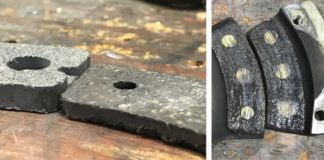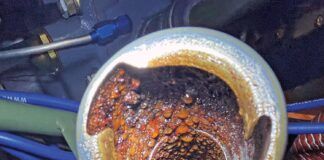Panel labeling is a small task that plays a huge role in the finished appearance of your instrument panel. There are dozens of ways to apply labels, from the simplest use of a permanent marker right on the instrument panel (dont laugh, some people do it), to masking tape, DYMO labels (remember those?) or some other, ah…shall we say expedient method? Sometimes function wins over aesthetics. And then there are elaborate, backlighted strips that conjure Las Vegas. Lets look at the most popular ways of performing this task.
Show Us Your Placard
The first and perhaps easiest way to label a panel is with placards or overlays of some sort. These are typically pieces of colored or painted plastic that are either engraved or printed with lettering. They are most often attached with adhesive tape, or the placards themselves may have an adhesive backing.
Several online supply houses offer pre-made placards for a variety of items such as the requisite passenger warning, engine/prop/mixture controls and more. Aircraft Spruce offers a complete sheet of pre-printed paper/vinyl labels that are simply peel-and-stick lettering. This is an economical and quick way to add labeling to your panel.
If you desire a more custom look, you can find a number of businesses that will customize placards for you. One of the most popular is Aircraft Engravers, which can supply placards to your specifications in multiple styles, colors and materials. The company has been doing this for many years and offers a whole range of products for your panel as well as custom rocker switch engraving, data plates and more. I can personally vouch for their workmanship, as we use their services for custom placards and overlays. The services are reasonably priced, and the proprietor, Wayne Cahoon, is a great guy to work with.
Office Depot Aviation Department
Another popular do-it-yourself method for lettering and labeling a panel is simply to use a basic electronic labeling machine. These are the label machines that use different cartridges and usually have a small keypad on them for typing out your message. The fussy types in your office probably use these to denote everything from what papers are in the file to who owns the Hang in There, Baby coffee cup.
Whats great about these devices are the time and cost. Most models will set you back $15 to $50 and will print a variety of adhesive labels and stickers, and heat-shrink via small cartridges that can be purchased at most office supply stores. These machines offer one of the few ways to print out white labels for darker panels.
The best labels to use for panels are the clear labels with colored lettering (such as white on clear, black on clear or red on clear). You decide on your font, type in your labels, and hit the print button. Then, peel off the backing and stick the clear label on your panel. A big advantage with this method is that if you don’t like the result, you can keep doing it over and over again until the panel looks exactly how you want. After you’ve applied your final set of labels, its a good idea to spray a layer of clear coat over them.
Do this with the following caveat: Test the labels on a scrap piece of painted aluminum first. Some clear-coat paint can melt or otherwise destroy your labels. Properly applied, the layer of clear coat will make the clear tape portion of the labels nearly disappear, leaving a nice finished label on your panel. Specific recommendations? We like the Brother series of labeling machines (like the $49 P-Touch PT-1880), as the cartridges are readily available in sizes from small to large and a variety of colors. When you’re done with the panel you can use the machine to label other items around the shop or house-just stay away from my Baby coffee mug!
Aye, Heres the Rub
Besides using stick-on labels, there is another nice way to add lettering to a panel. This is called rub-on lettering or, more technically, dry-transfer process. Several supply houses such as Aircraft Spruce offer pre-made sets of rub-on lettering in white or black, with a variety of wording.
To use these transfer sheets, your panel needs to be relatively flat and smooth. Cut out the desired label or word, place it upside down against the surface you wish to be labeled and gently burnish the lettering onto the panel with a blunt object or coin-sort of like scratching off a lottery ticket. The ink transfers from the paper to the panel, hence the name.
Rub-on decals can offer a clean and professional look, but one difficulty is accurately aligning a string of wording such as you would have in a row of switches or circuit breakers. Because each label is typically created individually, it is painfully difficult to get each and every label perfectly aligned, spaced and level with the entire row. Putting a piece of masking tape across the row will assist you in this process. As with the printed labels, an application of clear-coat is a good idea, as rub-on or dry-transfer lettering is relatively delicate and can be scratched or worn off easily.
Dry-transfer sheets can be custom- made by specialized shops. Do an Internet search for dry-transfer or Letraset sheets, and you’ll find a number of places that can do just about anything you desire. The downside is that custom sheets are expensive, on the order of $50 and up per sheet. For that same price you could buy a labeling machine and some cartridges to play with!
Regarding dry transfers, its worth mentioning another process from a company called Decal Pro. This is a process where you can create your own dry transfers (sort of) on your printer. We’ve played with this system in the past and can report firsthand that its labor intensive, you need to use their proprietary products/methods, and the result is often less than hoped for. Some homebuilders have had relative success with it, but overall Id recommend something else.
Decalomania
Next, and the most popular among professional panel shops, are plain old decals. Yep, the kind you used on model airplanes when you were a kid. These offer the best of both worlds, economy and customization. Decals are a quick and affordable way of labeling panels in a truly professional manner. This isn’t a process the average homebuilder can do at home on a computer, but customized decal sheets may be purchased from a huge number of online companies or from the shops that build panels.
Custom decal sheets are printed on a special printer that uses thermal transfer ink that is resistant to water, UV and, best of all, can be printed in almost any color including white and metallic foil. Decal sheets are printed directly from simple drawings, word processor files, CAD files or other online formats. Builders simply cut out the decal, word, image or row of words they desire, soak them in water for a few seconds and place them on the panel. The edges of the decal will be visible, and the decals can be damaged, so its important to cover these with a simple clear-coat. This will make the decals virtually disappear, leaving the images cleanly and sharply visible on the panel. Again, the standard caveat applies: Make sure you test one on a scrap before spraying your entire panel to avoid damaging the newly applied decals. Overall, decals are our favorite method of labeling. Its easy to do white, silver or other light colors on dark panels. They’re fast, and the end result is really nice.
Worm-Eye View
Lastly, lets take a look at good old-fashioned silkscreening. In years past, most shops (including ours) silkscreened all of the labels on panels, but we have since settled on decals as the best mix of value and results. Silkscreening labels results in a nice professional finish, but its labor intensive and can be costly.
Silkscreening is basically a process where you literally print labels, images or other shapes onto a surface (like your instrument panel) through the use of a silkscreen. The silkscreen is just that, a frame with tightly stretched porous silk (now synthetic material), which has certain areas chemically blocked off, leaving your letters or images in the porous material. You then push the ink through the screen onto your panel with a rubber squeegee.
Silkscreens are not something you should attempt to build yourself, but a quick online search for silkscreen supplier will find companies that will burn (or develop) a silkscreen for you. The physical screen with the service of etching your lettering/images into it will run between $35 to $100, depending on the size and turnaround time you require. Most companies will accept a CAD file, but for a small fee can convert other files as well. Its important when sending images to a silkscreen manufacturer to have your lettering and images exactly the size and spacing you require. Once the silkscreen has been chemically burned, you wont be able to alter it and will have to have a new screen made.
After you get your screen, you’ll need to purchase some ink. Again, ink suitable for silkscreening can be found in many craft stores and online. We don’t have enough room to go into the detail for every ink available, but you can use either water- or oil-based inks. Watery-type inks are bad, but so is ink that is too thick. The perfect type is one that has the consistency of molasses or honey. We like the Speedball brand inks available online. Once you’ve purchased a silkscreen and some ink, you’ll also need a rubber squeegee. This can normally be purchased from the same people who make the silkscreens, so remember to ask them to supply one with your screen.
After you’ve accumulated all of the various bits, you need to practice on something other than your finished panel. Practice on scrap sheets of aluminum. Its imperative that the surface of the area to be printed is clean and smooth. Any curves, dimples or other abnormalities will make a good silkscreen job impossible. Simply print (or squeeze) the ink through the screen into the desired area and then either let it cure on its own or gently apply some heat. One trick to make sure you get only the letters you want is to blank out the stuff you don’t want with masking tape. Tim Olson, RV-10 builder extraordinaire, has a short online tutorial showing how he silkscreened the labels on his instrument panel (see Resources for the web address). One last thing to remember is that, depending on the type of ink used, it may be a good idea to also cover your silkscreened labels with a clear-coat to keep them from being damaged.
Yet More Options
There are many other variations of the above methods for labeling your panel. You can have companies produce entire overlays of carbon fiber, wood, vinyl or other materials complete with labeling. You can have labels laser-engraved or even hand-lettered, and Im sure I forgot a bunch of other methods people have used to accomplish basically the same thing. The methods mentioned here represent the most popular ways to put labels on your panel and will provide you with a good end result for your project.
One of the last and most important things to remember is that most of the aforementioned methods require the panel to be relatively smooth and flat. If you choose to have a heavily textured surface -like trunk or crinkle paint-then your only real option is to go with a placard, because decals, rub-on labels or silkscreened labels will likely not turn out well. This is one of the main reasons we do not recommend a heavily textured panel coating.
Overall, if you take your time to lay out your desired labels, most of these methods will make you happy and provide a nice, professional looking panel. Or you could whip out the DYMO labeler. Your call.
If you have specific questions for author Stein Bruch, or have certain projects youd like us to cover, email us at [email protected] with About Avionics in the subject line.




